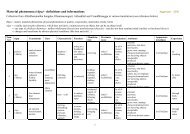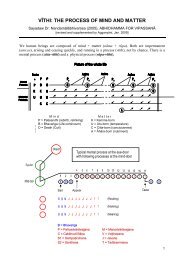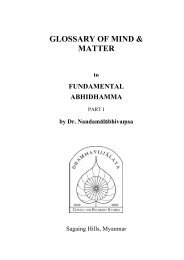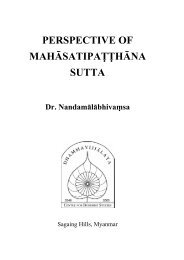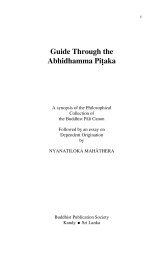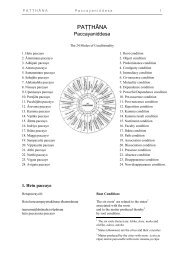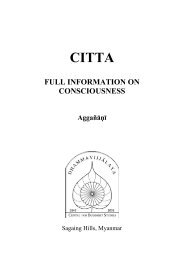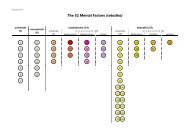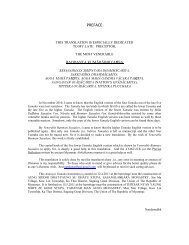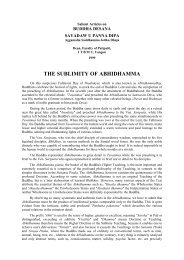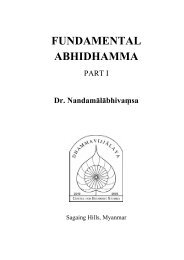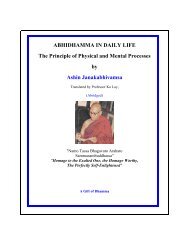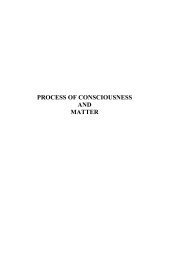Mahathera Ledi Sayadaw - Abhidhamma.com
Mahathera Ledi Sayadaw - Abhidhamma.com
Mahathera Ledi Sayadaw - Abhidhamma.com
You also want an ePaper? Increase the reach of your titles
YUMPU automatically turns print PDFs into web optimized ePapers that Google loves.
place side by side, the Santati-rupa is discernible. When the reproduction is excessive, the<br />
Apacaya-rupa is discernible. When the death of old matter is excessive, the Jarata-rupa is<br />
discernible. We have shown above that in every tree, root, branch, leaf, sprout, flower, and fruit<br />
there are these five salient marks. So, when we look at them with the aid of a microscope, we see<br />
that they are full of very infinitesimal organisms moving about as if they were living creatures;<br />
but in fact these are mere reproductions of matter produced by physical change.<br />
As regards the bodies of creatures or persons, these five salient marks are also discernible in every<br />
member of the body, such as, hair, hair of the body, finger-nails, toe-hails, teeth, the inner skin,<br />
the outer skin, muscles, nerves, veins big bones, small bones, marrow, kidney, heart, liver,<br />
membrane, lungs, intestines, entrails, undigested food, digested food, and the brain. So, when we<br />
look at them with the help of a microscope, moving organisms like very small creatures are seen.<br />
These are the reproductions of matter produced by Kamma, mind, food, and physical change.<br />
There may of course be microbes in some cases. Thus, if we look with the mind's eye, the mark of<br />
impermanence in all the matter of the whole body will clearly be discerned.<br />
What has just been expounded is the mark of impermanence in the matter.<br />
In mental phenomena, i.e., mind and its con<strong>com</strong>itants, the mark of impermanence which has two<br />
distinct features, the radical change (viparinama) and the subsequent change (annathabhava), is no<br />
less clearly to be seen. In the world, we all know that there are many different terms and<br />
expressions which are applied to the different modes and manners of the elements of mind and<br />
body which are incessantly rising and ceasing. For instance, there are two expressions, "seeing"<br />
and "not-seeing," which are used in describing the function of the eye. Seeing is the term assigned<br />
to the element of sight-consciousness; or, when we say "one sees," this is the term applied in<br />
describing the arising of sight-consciousness from the conjuncture of four causes, namely, eyebasis,<br />
visual-form, light, and attention. And when we say, "one does not see," this is the phrase we<br />
use in describing the non-existence of sight-consciousness. When, at night in the dark, no source<br />
of light is present, sight-consciousness does not arise upon the eye-basis; it is temporarily<br />
suspended. But it will arise when the light from a fire, for instance, is introduced. And when the<br />
light is put out, sight-consciousness also again will cease. As there are five salient marks present<br />
in the flame, if the light <strong>com</strong>es to be, seeing also <strong>com</strong>es to be, sight also arises. If the light<br />
develops, seeing also develops. If the light continues, seeing also continues. If the light decays,<br />
seeing also decays. And if the light ceases, then seeing also ceases. In the day-time also, these<br />
twin terms "seeing "not- seeing" may be made use of. If there is no obstruction, one sees; and if<br />
there is obstruction, one does not see. As regards eye-lids, if they are opened, one sees; and if they<br />
are shut, one does not see. What has just been expounded in the Viparinama and Annathabhava of<br />
sight- consciousness through the occasioning cause, light. In cases where the destruction of the<br />
eyebasis occurs after conception, sight consciousness also is lost for ever. If the visual form is<br />
taken away out of view, sight-consciousness also ceases. While sleeping, as there is no attention,<br />
so sight-consciousness subsides for some time. The genesis of all classes of consciousness that<br />
take part in the process of eye- door is to be understood by the term seeing"; and the subsidence of<br />
the same is to be understood by the term "not-seeing."<br />
Similarly in each function of hearing, smelling, tasting, and touching, a pair of expressions<br />
(existing or otherwise) is obtainable, and these must be dealt with as to their impermanency, i.e.,<br />
Viparinama and Annathabhava, in the same way as sight- consciousness. With regard to mindcognition,<br />
it has many different modes, and each is apparent in its nature of Viparinima and<br />
Annathabhava through the changes of the different kinds of thought. Among the mental<br />
con<strong>com</strong>itants, taking feeling for example, the changes of pleasure, pain, joy, grief, and hedonic<br />
indifference, are very evident. So also, the changes of perception, initial application, sustained<br />
application, from good to bad and vice versa, are very obvious. It may be easily noticed by<br />
anyone that in the single posture of sitting alone, greed, disinterestedness, hate, and amity, are<br />
each rising by turns.



